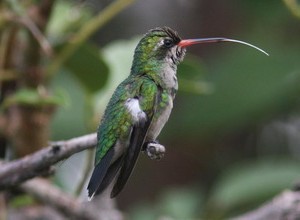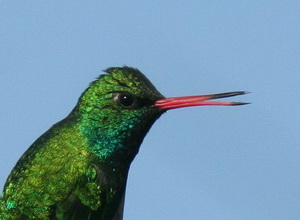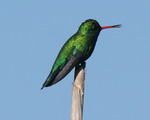Hummingbirds keep a close relationship with flowers since they produce nectar, one of the basic components of hummingbirds´ diet. This reward is compensated for by the involuntary provision of polen, which promotes cross-pollination. Nectar constitutes 90% of their diet. This sugar- and amino acid-rich liquid is transformed into energy, most of which is consumed to perform an energetically expensive flight type (see Flight Technique). To lap up nectar hummingbirds stay aloft before the flower, introduce their bills to reach the nectaries, which are in the base of the corolla, and drink the sweet liquid with the tongue. The tongue has special characteristics. It is long and can double the bill in size. When not in use it is "circling" the rear part of the head connected to the hyoid apparatus, the muscles of which extend and contract the tongue. It is split in the tip. These extremes join to channel nectar into the mouth. Hummingbirds protrude the tongue 13 times a second without opening the bill.
 |
 |
| Left: The tongue doubles the bill in size. It protrudes the tongue without opening the bill. Right: Rhynchokinesis: capacity to open the distal portion of the bill | |
|---|---|
 |
 |
 |
 |
| Incursión aérea para atrapar insectos | |||
|---|---|---|---|
 |
||
| And getting off the subject: the eyelashes of the hummingbird, small tufts of feathers Photos © Roberto Ares | ||
|---|---|---|




